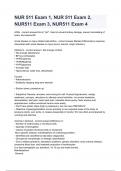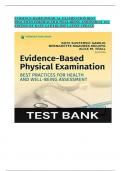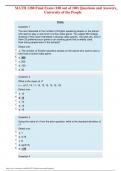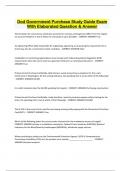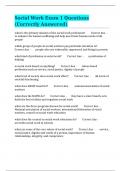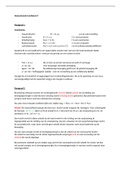NUR 511 Exam 1, NUR 511 Exam 2,
NUR511 Exam 3, NUR511 Exam 4
ACEs - correct answer-End in "pril". Used to prevent kidney damage, prevent remodeling of
heart, and reduce BP.
Acute disease or injury related malnutrition - correct answer-Marked inflammatory response.
Associated with acute disease or injury (burns, trauma, major infection).
Addison's - correct answer-• Not enough cortisol
• Not enough aldosterone
• BP low (orthostatic)
• HYPOnatremia
• HYPERkalemia
• HYPOglycemia
• Increase Salt
• Hypovolemia, water loss, dehydration
Causes:
• Adrenalectomy
• Suddenly stopping long term steroids
• Sodium down, potassium up
• Subjective: Nausea, anorexia, and craving for salt. Postural hypotension, vertigo,
weakness, syncope, reluctance to attempt normal activities. c/o severe headache,
disorientation, abd pain, lower back pain, tolerates stress poorly, feels anxious and
apprehensive, suffers emotional trauma more easily,
• Can't have potato chips (high in potassium), but can have PRETZELS!
• Objective: Hyperpigmentation occurs primarily in sun-exposed areas of the body, at
pressure points, over joints, in creases (especially in hands). Wt. loss often accompanied by
vomiting and diarrhea,
Anemia in General - correct answer-Deficiency in:
- Number of erythrocytes or red blood cells
- Quantity of hemoglobin
- Volume of packed red blood cells or hematocrit
Not a specific disease; manifestations of underlying problem:
- Identified and classified by laboratory diagnostics
- Grouped by morphologic or etiologic classification
- Due to dietary problems, absorption problems, genetic disorders, bone marrow disease,
excessive blood loss, and impaired production of erythrocytes
8 or less hemoglobin you transfuse, 10-12 you are really worried.
Manifestations
General:
,- Fatigue, increased somnolence, lethargy, and apathy
Cardiopulmonary:
- Tachycardia, palpitations, and orthostatic hypotension
- Angina, MI, and CHF (severe)
- Tachypnea, dyspnea, and decreased oxygen saturations
Integumentary changes:
- Pallor, pruritus, jaundice, and cool skin
CNS:
- Headache, dizziness, irritability, impaired thought processes, dim vision, and depression
Other:
- Anorexia, hepatomegaly, splenomegaly, sore mouth, bone pain, weight loss, sensitivity to
cold, cool, clammy skin, night cramps, and oliguria
Aortic regurgitation - correct answer-Backflow of blood from ascending aorta into LV during
diastole. LV volume overload, increased LA pressure, pulmonary congestion/hypertension,
results in right side failure.
Acute: cardiovascular collapse (severe hypotension, CP, dyspnea)
Chronic: s/s HF, throbbing pulse in neck, deMisset's sign (head bob), diastolic murmur, s3
and s4, widened pulse pressure, unresponsive angina.
No nitro!!!
Treatments: same as HF with addition of anticoagulants and prophylactic antibiotics.
Aortic stenosis - correct answer-Obstructs blood flow from LV to aorta during systole. LV has
to work harder, hypertrophies.
Increased workload, causes ischemia.
Pressure backs up causing pulmonary congestion/edema.
Left sided HF.
Symptoms: DOE, angina, Exertional syncope! (Know these)
Narrowed pulse pressure, harsh systolic murmur, diminishe for absent S2, s3 and s4,
Artherocentesis - correct answer-take sample of synovial fluid from joint. Give joint rest
afterward, ice joint, acetaminophen, all for 24 hours. Check for synovial fluid leaking.
Beta blockers for HF - correct answer-Carvedilol, metoprolol XL, zebeta. Block
catacholamines.
Biologic and Targeted Therapy - correct answer-Biologic response modifier therapy
o Modify the relationship b/t host & tumor by altering biologic response of the host to the
tumor cells
Direct anti-tumor effects
Restore, augment, modulate host immune system
Effects that interfere with cancer's ability to metastasize or differentiate
Ex: interferons, interleukins
Targeted
o Interferes with cancer growth by targeting specific cellular receptors & pathways necessary
for tumor growth
o Because more selective for specific targets, tend to cause less damage to normal cells
,o Ex: monoclonal antibodies, tyrosine kinase inhibitors angiogenesis inhibitors, proteosome
inhibitors
o NI: for flu-like sx = acetaminophen before and every 4 hours after tx., IV Demerol to control
chills, monitor VS, planned rest periods, assist with ADL's; for neurologic problems = safety
& supportive measures
Biological DMARDS - correct answer-Enbrel [SQ], Remicade [IV], Humira [SQ],
◦ Non-TNF biological
WBC modulators: Orencia [IV] & Rituxan [IV]
Interleukin-1 inhibitior: Kineret [SQ]
Interleukin-6 inhibitor: Actemra [IV]
Tofacitinib (Xeljanz)
◦ Common SE of these drugs
Injection site reactions (ice & hydrocortisone), rotate sites
Increased risk of infection, certain cancers (e.g. lymphoma), reactivation of hepatitis B;
routine CBC
Infusion reactions (chest discomfort, tachycardia, SOB)
◦ Give acetaminophen & Benadryl prophylactically
Observe for infections, respiratory complications, heart failure, delayed wound healing
Don't use if TB or MS (Kineret okay)
Don't receive live vaccines
Refrigerate all except Remicade
Risk of anaphylaxis with Remicade
If you get infection while on these (action is to block T and B cells), can get very sick!
Bladder Cancer - correct answer-Treatments
• Intravesical or systemic (if mets) chemotherapy
• Laser photocoagulation or loop resection
• Radiation therapy
• Intravesical immunotherapy
- BCGLive - attenuated Mycobacterium bovis
- Interferon
• Causes local inflammation to eliminate/reduce superficial tumors & prevent recurrence and
stimulates immune system
Surgical Treatment
• Resection of tumor (transurethral or open)
- Simple resection
- Partial/segmental cystectomy (for single isolate bladder tumor)
• Radical cystectomy (if invasive)
- Ileal conduit
• Continual urine drainage (requires appliance), teach how to manage stoma, continuous
drainage, empty reservoir.
- Continent urinary reservoir
• Nipple valve created; catheterize valve
- Neobladder
• No urge to void, timed voiding
- Ureterosigmoidostomy/uteroileosigmoidostomy
- Ileocystoplasty (male only)
, Nursing Interventions-
• Minimally invasion surgical procedures
- 2.5-3 L fluid/day
- Avoid alcohol
- Teach to monitor urine output & characteristics
- Sitz bath 2-3 x's qd 1st week
- Teach importance of routine monitoring
- Pain medication
• Radiation/Chemotherapy/Immunotherapy
- Increase fluids
- Monitor for UTI
- If radiation, monitor urine stream/flow
Cystectomy
• Pre-op
- Bowel cleansing
• Neomycin
• Enemas until clear
- Clear liquid several days before OR & NPO 8 hours for immediate pre-op period
- Enterostomal therapist to mark stoma site
• Post-op
- Routine post-op care
- Observe stoma
- Observe urine
• Pink-tinged early post-op
• Discharge instructions
- Stoma/appliance care (clean technique)
• Early edematous - will shrink in size & appliance adjustments will need to occur
• Stoma appearance should be dark pink
• Empty when 1/3 full (to prevent reflux)
- High fluid intake (2500-3000 mL/d)
- Sitz bath 2-3 x's/d
- Advise of urine characteristics with ileal conduit
• Mucus shreds normal
- Sta
Blood Cell Levels - correct answer-RBCs men-4.2-5.5 ( x 10^/µL)
RBCs Women: 3.6-5.0
Reticulocytes: 1 -1.5% of total RBCs
Hemoglobin: men-14-16.5 g/dl women-12-16 g/dl
Hematocrit: men-40-50% women-37-47%
MCV- 85-100 fL
MCH-27-44 pg/cell
MCHC- 31-35 g/dl
WBCs (leukocyte) -4.8-10.8 (x 10³/µL)
Neutrophils - 47-63 % of WBCs
Absolute Neutrophil count (ANC) :
WBC x ( % neutrophils x % bands)
Thrombocytes (Platelets)- 150-400,000 (150-400x 10³)

